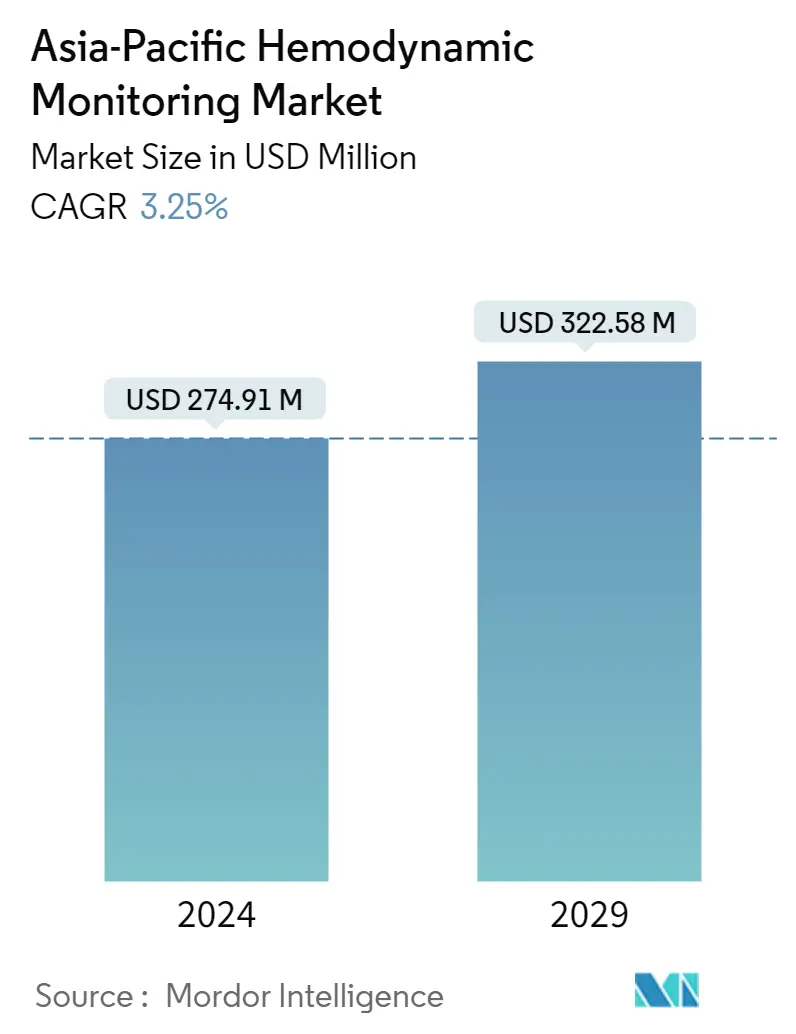Market Size of Asia-Pacific Hemodynamic Monitoring Industry

| Study Period | 2021 - 2029 |
| Base Year For Estimation | 2023 |
| Market Size (2024) | USD 274.91 Million |
| Market Size (2029) | USD 322.58 Million |
| CAGR (2024 - 2029) | 3.25 % |
| Market Concentration | Medium |
Major Players
*Disclaimer: Major Players sorted in no particular order |
Need a report that reflects how COVID-19 has impacted this market and its growth?
Asia-Pacific Hemodynamic Monitoring Market Analysis
The Asia-Pacific Hemodynamic Monitoring Market size is estimated at USD 274.91 million in 2024, and is expected to reach USD 322.58 million by 2029, growing at a CAGR of 3.25% during the forecast period (2024-2029).
COVID-19 had a substantial market impact as the pandemic witnessed a sudden surge in the need for hemodynamic monitoring solutions for patients with SARS-CoV-2 infections. For instance, according to the LiDCO Group PLC's press release for 2021, demand for hemodynamic monitoring equipment increased from many existing customers, with significant short-term heightened demand from various hospitals in several countries, including a small number of monitors sold in Wuhan, China. Furthermore, some COVID-19 patients developed complications such as sepsis and required intensive care, wherein the healthcare settings were required to make use of advanced hemodynamic monitoring systems to improve patient outcomes. Hence, COVID-19 substantially boosted market demand for hemodynamic monitoring devices amid the pandemic. However, as per the analysis, the sudden heightened demand is likely to see a decline over the post-pandemic phase owing to the lesser number of COVID-19 patients and blood-related complications associated with these patients.
The key factors propelling the Asia-Pacific hemodynamic monitoring market are the increase in the critically ill geriatric population and the rising burden of various chronic diseases and cardiac disorders. According to OECD data updated in 2021, the percentage of the population aged 65 and over in China in 2020 was 11.97%. As a result, the demand for hemodynamic monitoring is projected to accelerate in the future, augmenting the growth of the studied market, as the elderly population is more susceptible to age-related blood disorders, such as hypertension, cardiovascular disease disorders, and cancers.
Insights on vital information such as blood volume, heart contractility, and fluid balance can be obtained through hemodynamic parameters in patients suffering from chronic diseases. all of which are required to assess the patient's general health and the efficacy of their treatment. The region is witnessing a surge in the prevalence and incidence of chronic disease over the past few years. For instance, the research article published in April 2022 in the International Journal of Public Health mentioned that CVD is one of the major healthcare burdens in China. According to the article, 290 million people are currently suffering from cardiac disorders, with stroke accounting for 13 million, coronary heart disease accounting for 11 million, rheumatic heart disease accounting for 2.5 million, heart failure accounting for 4.5 million, congenital heart disease accounting for 2 million, pulmonary heart disease accounting for 5 million, and hypertension accounting for 245 million. Moreover, out of the total mortality related to CVD, 40% occurs in China alone. Therefore, the increasing cases of CVDs are expected to increase the demand for hemodynamic monitoring systems, which is further expected to boost the growth of the Asia-Pacific hemodynamic monitoring market over the forecast period.
Therefore, owing to the aforementioned factors, it is anticipated that the studied market will witness growth over the analysis period. However, increased incidences of complications associated with invasive monitoring systems and stringent guidelines for the approval of new systems are expected to hinder the growth of the market.
